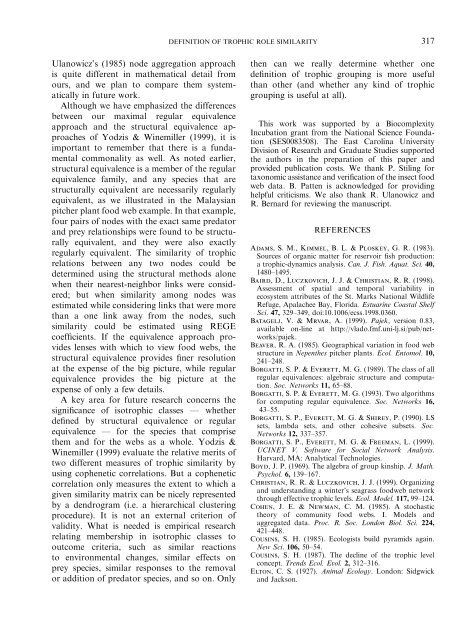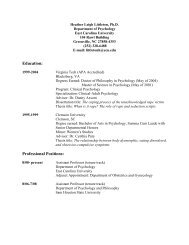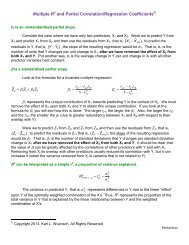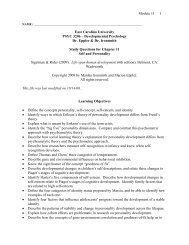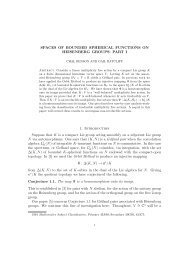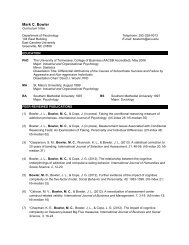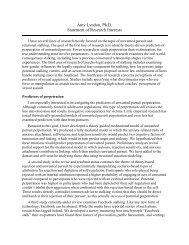Defining and Measuring Trophic Role Similarity in Food Webs Using ...
Defining and Measuring Trophic Role Similarity in Food Webs Using ...
Defining and Measuring Trophic Role Similarity in Food Webs Using ...
You also want an ePaper? Increase the reach of your titles
YUMPU automatically turns print PDFs into web optimized ePapers that Google loves.
DEFINITION OF TROPHIC ROLE SIMILARITY 317Ulanowicz’s (1985) node aggregation approachis quite different <strong>in</strong> mathematical detail fromours, <strong>and</strong> we plan to compare them systematically<strong>in</strong> future work.Although we have emphasized the differencesbetween our maximal regular equivalenceapproach <strong>and</strong> the structural equivalence approachesof Yodzis & W<strong>in</strong>emiller (1999), it isimportant to remember that there is a fundamentalcommonality as well. As noted earlier,structural equivalence is a member of the regularequivalence family, <strong>and</strong> any species that arestructurally equivalent are necessarily regularlyequivalent, as we illustrated <strong>in</strong> the Malaysianpitcher plant food web example. In that example,four pairs of nodes with the exact same predator<strong>and</strong> prey relationships were found to be structurallyequivalent, <strong>and</strong> they were also exactlyregularly equivalent. The similarity of trophicrelations between any two nodes could bedeterm<strong>in</strong>ed us<strong>in</strong>g the structural methods alonewhen their nearest-neighbor l<strong>in</strong>ks were considered;but when similarity among nodes wasestimated while consider<strong>in</strong>g l<strong>in</strong>ks that were morethan a one l<strong>in</strong>k away fromthe nodes, suchsimilarity could be estimated us<strong>in</strong>g REGEcoefficients. If the equivalence approach provideslenses with which to view food webs, thestructural equivalence provides f<strong>in</strong>er resolutionat the expense of the big picture, while regularequivalence provides the big picture at theexpense of only a few details.A key area for future research concerns thesignificance of isotrophic classes F whetherdef<strong>in</strong>ed by structural equivalence or regularequivalence F for the species that comprisethem<strong>and</strong> for the webs as a whole. Yodzis &W<strong>in</strong>emiller (1999) evaluate the relative merits oftwo different measures of trophic similarity byus<strong>in</strong>g cophenetic correlations. But a copheneticcorrelation only measures the extent to which agiven similarity matrix can be nicely representedby a dendrogram(i.e. a hierarchical cluster<strong>in</strong>gprocedure). It is not an external criterion ofvalidity. What is needed is empirical researchrelat<strong>in</strong>g membership <strong>in</strong> isotrophic classes tooutcome criteria, such as similar reactionsto environmental changes, similar effects onprey species, similar responses to the removalor addition of predator species, <strong>and</strong> so on. Onlythen can we really determ<strong>in</strong>e whether onedef<strong>in</strong>ition of trophic group<strong>in</strong>g is more usefulthan other (<strong>and</strong> whether any k<strong>in</strong>d of trophicgroup<strong>in</strong>g is useful at all).This work was supported by a BiocomplexityIncubation grant fromthe National Science Foundation(SES0083508). The East Carol<strong>in</strong>a UniversityDivision of Research <strong>and</strong> Graduate Studies supportedthe authors <strong>in</strong> the preparation of this paper <strong>and</strong>provided publication costs. We thank P. Stil<strong>in</strong>g fortaxonomic assistance <strong>and</strong> verification of the <strong>in</strong>sect foodweb data. B. Patten is acknowledged for provid<strong>in</strong>ghelpful criticisms. We also thank R. Ulanowicz <strong>and</strong>R. Bernard for review<strong>in</strong>g the manuscript.REFERENCESAdams, S. M., Kimmel, B.L.&Ploskey, G. R. (1983).Sources of organic matter for reservoir fish production:a trophic-dynamics analysis. Can. J. Fish. Aquat. Sci. 40,1480–1495.Baird, D., Luczkovich, J.J.&Christian, R. R. (1998).Assessment of spatial <strong>and</strong> temporal variability <strong>in</strong>ecosystemattributes of the St. Marks National WildlifeRefuge, Apalachee Bay, Florida. Estuar<strong>in</strong>e Coastal ShelfSci. 47, 329–349, doi:10.1006/ecss.1998.0360.Batagelj, V.&Mrvar, A. (1999). Pajek, version 0.83,available on-l<strong>in</strong>e at http://vlado.fmf.uni-lj.si/pub/networks/pajek.Beaver, R. A. (1985). Geographical variation <strong>in</strong> food webstructure <strong>in</strong> Nepenthes pitcher plants. Ecol. Entomol. 10,241–248.Borgatti, S.P.&Everett, M. G. (1989). The class of allregular equivalences: algebraic structure <strong>and</strong> computation.Soc. Networks 11, 65–88.Borgatti,S.P.&Everett, M. G. (1993). Two algorithmsfor comput<strong>in</strong>g regular equivalence. Soc. Networks 16,43–55.Borgatti, S. P., Everett, M.G.&Shirey, P. (1990). LSsets, lambda sets, <strong>and</strong> other cohesive subsets. Soc.Networks 12, 337–357.Borgatti, S. P., Everett, M.G.&Freeman, L. (1999).UCINET V. Software for Social Network Analysis.Harvard, MA: Analytical Technologies.Boyd, J. P. (1969). The algebra of group k<strong>in</strong>ship. J. Math.Psychol. 6, 139–167.Christian, R.R.&Luczkovich, J. J. (1999). Organiz<strong>in</strong>g<strong>and</strong> underst<strong>and</strong><strong>in</strong>g a w<strong>in</strong>ter’s seagrass foodweb networkthrough effective trophic levels. Ecol. Model. 117, 99–124.Cohen, J. E. & Newman, C. M. (1985). A stochastictheory of community food webs. I. Models <strong>and</strong>aggregated data. Proc. R. Soc. London Biol. Sci. 224,421–448.Cous<strong>in</strong>s, S. H. (1985). Ecologists build pyramids aga<strong>in</strong>.New Sci. 106, 50–54.Cous<strong>in</strong>s, S. H. (1987). The decl<strong>in</strong>e of the trophic levelconcept. Trends Ecol. Evol. 2, 312–316.Elton, C. S. (1927). Animal Ecology. London: Sidgwick<strong>and</strong> Jackson.


